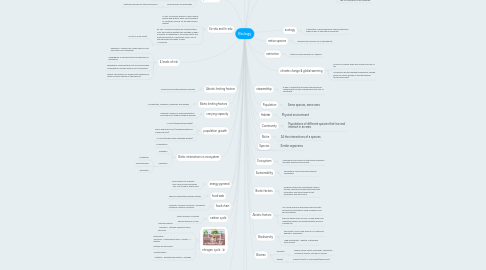Biology
por Gabriela Melendez


1. Nutrients
1.1. Substances that an organism uses to build and repair the cells of it's body
1.2. Provides energy
1.3. Animals eat food to get nutrients
1.4. Plants get nutrients from the soil
1.5. Nutrients cycle back and forth between biotic and abiotic parts
2. water cycle
2.1. Evaporation/ Transpiration, Condensation, Precipitation, Run-off, collection/ Seepage/ Root uptake
3. nitrogen cycle
3.1. Nitrogen fixation Nitrogen + Nitrogen fixing bacteria = ammonia
3.2. Nitrification Ammonia + nitrifying bacteria = nitrites --> nitrates Nitrates go into plants
3.3. Denitrification Nitrates + denitrifying bacteria = nitrogen
4. carbon cycle
4.1. Biotic reservoir of forests Abiotic reservoir of coal
5. food chain
5.1. Producer> primary consumer> secondary consumer>tertiary consumer
6. food web
6.1. Shows complicated feeding relations
7. energy pyramid
7.1. 60% passed out as waste 30% used in body processes and 10% stored in body tissue
8. Biotic interactions in ecosystem
8.1. Competition
8.2. Predation
8.3. Symbiosis
8.3.1. mutualism
8.3.2. commensalism
8.3.3. parasitism
9. population growth
9.1. J-Curve (Exponential growth)
9.2. Boom and Bust Curve (Sudden growth and sudden decline)
9.3. S-Curve (Sudden then Plateaued growth)
10. carrying capacity
10.1. Maximum number of individuals that an ecosystem can support without damage
11. Biotic limiting factors
11.1. Competition, Predation, Parasitism and disease
12. Abiotic limiting factors
12.1. Forest fires and other extreme climates
13. 4 levels of risk
13.1. Expiration: a species no longer exists in One place but occur elsewhere
13.2. Endangered: a species that faces extinction or extirpation
13.3. Threatened: a species that is at risk of becoming endangered if limiting factors are not reversed
13.4. extinct: the species no longer exists anywhere,é death of every member in that species
14. Ex-situ and In-situ
14.1. In-situ: Conserves species in their natural habitat and protect them from predators or creating a reserve for the species and habitat.
14.2. Ex-situ: Conserves species by removing them from their natural habitats this strategy is when a species is threatened or no longer exist if the existing population is extremely small. The at risk individuals are taken to zoos or reserves
14.2.1. Ex-situ is a last resort
15. pest control
15.1. Integrated pest management uses knowledge about pests biology and habitat rather than using pesticides
15.2. some farmers use pesticides
15.2.1. Pesticides are bad for the environment
16. habitat change
16.1. Humans alter or destroy a habitat in which the native species that lived there can't live in it anymore
16.2. A reason humans may change habitats is when all resources are depleted or the habitat isn't sustainable anymore
17. competition
17.1. Similar species that feed on the same prey avoid competition by eating in different parts of the area
18. Species
18.1. Similar organisms
19. Population
19.1. Same species, same area
20. Habitat
20.1. Physical environment
21. Community
21.1. Populations of different species that live and interact in an area
22. Ecosystem
22.1. a biological community of interacting organisms and their physical environment.
23. Niche
23.1. All the interactions of a species
24. Biotic factors
24.1. organisms which are living things such as animals, people and plants that effect the ecosystem and other things in that ecosystem that they live in.
25. Abiotic factors
25.1. non-living chemical and physical parts of the environment that affect living organisms and the ecosystems
25.2. physical things such as rocks, air and water and measured things such as temperature, hours of sunlight etc.
26. Sustainability
26.1. Populations can produce and interact indefinitely
27. Biodiversity
27.1. the variety of life in the world or in a particular habitat or ecosystem.
27.2. High biodiversity = healthy, sustainable environment
28. Biomes
28.1. terrestial
28.1.1. tundra, boreal forest, grasslands, Temperate coniferous forests, Deciduous forests
28.2. aquatic
28.2.1. marine (ocean) or fresh water(lakes rivers)
29. Biosphere: 3 components that make it
29.1. Atmosphere
29.1.1. Layer of gases that surrounds the earth (Air)
29.2. Hydrosphere
29.2.1. All the water on earth
29.3. lithosphere
29.3.1. Earth's solid outer layer ( the crust)
